
| |
My Personal Astronomy Page...

![]()
![]()
![]()
![]()
![]()
![]()
![]()
![]()
![]()
![]()
![]()
![]()
![]()
![]()
![]()
![]()
![]()
![]()
![]()
![]()
![]()
![]()

|
|
|
STAR CHART |
|||||||||
| -- ACAMAR | -- Alzirr | -- Electra | -- Merga | -- SAIPH | |||||
| -- ACHERNAR | -- Ancha | -- ELNATH | -- Merope | -- Salm | |||||
| -- Achird | -- Angetenar | -- ENIF | -- Mesarthim | -- Sargas | |||||
| -- ACRUX | -- ANKAA | -- ETAMIN | -- Metallah | -- Sarin | |||||
| -- Acubens | -- Anser | -- FOMALHAUT | -- Miaplacidus | -- Sceptrum | |||||
| -- ADARA | -- ANTARES | -- Fornacis | -- Minkar | -- SCHEAT | |||||
| -- Adhafera | -- ARCTURUS | -- Fum al Samakah | -- MINTAKA | -- Secunda Giedi | |||||
| -- Adhil | -- Arkab Posterior | -- Furud | -- MIRA | -- Segin | |||||
| -- AGENA | -- Arkab Prior | -- Gacrux | -- MIRACH | -- Seginus | |||||
| -- Ain al Rami | -- ARNEB | -- Gianfar | -- Miram | -- Sham | |||||
| -- Ain | -- Arrakis | -- Gienah Cygni | -- MIRPHAK | -- Sharatan | |||||
| -- Al Anz | -- Ascella | -- Gienah Ghurab | -- MIZAR | -- SHAULA | |||||
| -- Al Kalb al Rai | -- Asellus Australis | -- Gomeisa | -- Mufrid | -- SHEDIR | |||||
| -- Al Minliar al Asad | -- Asellus Borealis | -- Gorgonea Quarta | -- Muliphen | -- Sheliak | |||||
| -- Al Minliar al Shuja | -- Asellus Primus | -- Gorgonea Secunda | -- Murzim | -- SIRIUS | |||||
| -- Aladfar | -- Asellus Secondus | -- Gorgonea Tertia | -- Muscida | -- Situla | |||||
| -- Alathfar | -- Asellus Tertius | -- Graffias | -- Muscida | -- Skat | |||||
| -- Albaldah | -- Asterope | -- Grafias | -- Muscida | -- SPICA | |||||
| -- Albali | -- Atik | -- Grumium | -- Nair al Saif | -- Sterope II | |||||
| -- ALBIREO | -- Atlas | -- HADAR | -- Naos | -- Sualocin | |||||
| -- Alchiba | -- Auva | -- Haedi | -- Nash | -- Subra | |||||
| -- ALCOR | -- Avior | -- HAMAL | -- Nashira | -- Suhail al Muhlif | |||||
| -- ALCYONE | -- Azelfafage | -- Hassaleh | -- Nekkar | -- Sulafat | |||||
| -- ALDEBARAN | -- Azha | -- Head of Hydrus | -- NIHAL | -- Syrma | |||||
| -- ALDERAMIN | -- Azmidiske | -- Herschel's "Garnet Star" | -- Nodus Secundus | -- Tabit (1543) | |||||
| -- Aldhibah | -- Baham | -- Heze | -- NUNKI | -- Tabit (1544) | |||||
| -- Alfecca Meridiana | -- Baten Kaitos | -- Hoedus II | -- Nusakan | -- Tabit (1552) | |||||
| -- Alfirk | -- Becrux | -- Homam | -- Peacock | -- Tabit (1570) | |||||
| -- ALGENIB | -- Beid | -- Hyadum I | -- PHAD | -- Talitha | |||||
| -- ALGIEBA | -- BELLATRIX | -- Hyadum II | -- Phaet | -- Tania Australis | |||||
| -- ALGOL | -- BETELGEUSE | -- IZAR | -- Pherkad Minor | -- Tania Borealis | |||||
| -- Algorab | -- Botein | -- Jabbah | -- Pherkad | -- TARAZED | |||||
| -- ALHENA | -- Brachium | -- Kaffaljidhma | -- Pleione | -- Taygeta | |||||
| -- ALIOTH | -- CANOPUS | -- Kajam | -- Polaris Australis | -- Tegmen | |||||
| -- ALKAID | -- CAPELLA | -- KAUS AUSTRALIS | -- POLARIS | -- Tejat Posterior | |||||
| -- Alkalurops | -- Caph | -- Kaus Borealis | -- POLLUX | -- Terebellum | |||||
| -- Alkes | -- CASTOR | -- Kaus Meridionalis | -- Porrima | -- Thabit | |||||
| -- Alkurhah | -- Cebalrai | -- Keid | -- Praecipua | -- Theemim | |||||
| -- ALMAAK | -- Celaeno | -- Kitalpha | -- Prima Giedi | -- THUBAN | |||||
| -- ALNAIR | -- Chara | -- KOCAB | -- PROCYON | -- Torcularis Septentrionalis | |||||
| -- ALNATH | -- Chort | -- Kornephoros | -- Propus | -- Turais | |||||
| -- ALNILAM | -- COR CAROLI | -- Kraz | -- Propus | -- Tyl | |||||
| -- ALNITAK | -- Cursa | -- Kuma | -- Propus | -- UNUKALHAI | |||||
| -- Alniyat | -- Dabih | -- Lesath | -- Rana | -- VEGA | |||||
| -- Alniyat | -- Deneb Algedi | -- Maasym | -- Ras Elased Australis | -- VINDEMIATRIX | |||||
| -- ALPHARD | -- Deneb Dulfim | -- Maia | -- Ras Elased Borealis | -- Wasat | |||||
| -- ALPHEKKA | -- Deneb el Okab [Epsilon Aquilae] | -- Marfak | -- RASALGETHI | -- Wezen | |||||
| -- ALPHERATZ | -- Deneb el Okab [Zeta Aquilae] | -- Marfak | -- RASALHAGUE | -- Wezn | |||||
| -- Alrai | -- Deneb Kaitos Shemali | -- Marfic | -- Rastaban | -- Yed Posterior | |||||
| -- Alrisha | -- DENEB | -- Marfik | -- REGULUS | -- Yed Prior | |||||
| -- Alsafi | -- DENEBOLA | -- MARKAB | -- Rigel Kentaurus | -- Yildun | |||||
| -- Alsciaukat | -- Dheneb | -- Matar | -- RIGEL | -- Zaniah | |||||
| -- ALSHAIN | -- Diadem | -- Mebsuta | -- Rijl al Awwa | -- Zaurak | |||||
| -- Alshat | -- DIPHDA | -- MEGREZ | -- Rotanev | -- Zavijah | |||||
| -- Alsuhail | -- Double Double (7051) | -- Meissa | -- Ruchba | -- Zibal | |||||
| -- ALTAIR | -- Double Double (7052) | -- Mekbuda | -- Ruchbah | -- Zosma | |||||
| -- Altarf | -- Double Double (7053) | -- Menkalinan | -- Rukbat | -- Zuben Elakrab | |||||
| -- Alterf | -- Double Double (7054) | -- MENKAR | -- Sabik | -- Zuben Elakribi | |||||
| -- Aludra | -- Dschubba | -- Menkar | -- Sadalachbia | -- Zuben Elgenubi | |||||
| -- Alula Australis | -- Dsiban | -- Menkent | -- SADALMELIK | -- Zuben Elschemali | |||||
| -- Alula Borealis | -- DUBHE | -- Menkib | -- Sadalsuud | ||||||
| -- Alya | -- Ed Asich | -- MERAK | -- Sadr |
 |
||

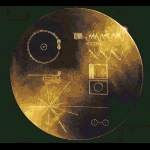
|
ASTRO GLOSSARY
Asteroid: A small planet that measures only a few hundred kilometers and has no atmosphere. Atmosphere: A layer of gas surrounding certain celestial objects, in particular the Earth. Big Bang: An event comparable to a gigantic dilation of the universe over time that apparently lead to its creation. The dilation (also called "expansion") is broken down into four main steps: the first, the "particle era," lasted only one second; the second phase, the "nuclear era," corresponds to about 100 seconds; the third, the "radiative material era," represents 300,000 years. The fourth phase is called the "stellar" phase. About 15 billion years have elapsed from the creation of the universe to the present date. Binary or Double Star: A system of two stars connected by their mutual gravitational field. Each star may itself be a double star. The main star is brighter than the second, which is called a "companion". Black Hole: A region of the universe where the gravitational field is so intense that nothing, not even light, can get out. Nothing inside it can communicate with the outside by any means whatsoever. Blue Giant Star: A young star, with three to five times the Sun's mass and 100 times its luminosity. Blue Supergiant Star: A very rare type of star in the galaxy. It is young, massive, hot (its surface temperature is about 30,000°C) and bright (it shines more brightly than 10,000 suns). Celestial/Heavenly Body: Any natural object in the sky (planet, comet, star, galaxy, for instance). Cluster: A group of stars from the same galaxy (star cluster) connected by their mutual gravitational force. Comet: A small body formed of rock and ice that releases large quantities of gas and dust and becomes bright as it approaches the Sun. Constellation: A group of stars, appearing to be in close proximity, that draw an arbitrary shape in the sky. Ancient civilizations have generally named constellations after an animal or hero in ancient mythology. In 1922, the International Astronomical Union set up boundaries in the sky and divided it up into 88 constellations. Cosmological Constant: A term in Einstein's general relativity equations that leads to an acceleration of the expansion of the Universe. Usually denoted by Λ, the capital Greek letter Lambda when expressed with units of inverse length squared, or by ΩΛ or the lower-case Greek lambda (λ) when normalized to the critical density like Ω. Dark Energy: A more general form of the vacuum energy density than the cosmological constant. Dark Matter: A form of matter that does not emit light, absorb light, or scatter light. Its only interactions are gravitational. Eclipsing Binary Star: A system of two stars that pass alternatively one behind the other, thereby hiding each other to an extent that reflects the orbit angle and the diameter of the two stars. Electromagnetic Force: One of the four forces of nature. Electromagnetic interactions hold electrons in atoms, hold atoms in molecules, and are used in all electronic devices. Electromagnetic Radiation: A form of energy characterized by the existence of closely associated variable electrical and magnetic fields, that spreads through empty space at a constant speed of about 300,000 kilometers per second. Light is an example of electromagnetic radiation. Exoplanet: A planet revolving around a star other than the Sun. Also called and extra-solar planet. Expansion: The dilation of the universe over time. Galaxy: A gigantic group of stars and interstellar material (gas and dust) held together by gravitation (mutual attraction). The universe has tens of billions of galaxies. Galaxy Cluster: A large grouping of ten to several thousand galaxies. Globular Cluster: A very dense, compact cluster containing hundreds of thousands of very old stars (about 15 billion years old), remnants of our galaxy's formation. Gravitational Collapse: A cataclysmic event in the life of a star, occuring when the gravitational forces inside the star are stronger than its nuclear forces. Light-year: A unit of distance (LY) equal to the distance that light or any other electromagnetic radiation travels in one year. Light travels at 300,000 kilometers per second, therefore, one light-year equals 10,000,000,000,000 kilometers. Meteor: The light emitted from a meteoroid or an asteroid as it enters the atmosphere. Meteoroid: A small rocky, iron or icy debris flying in space. Milky Way: This is our galaxy. It is shaped like a disk measuring 100,000 light-years in diameter and is 10,000 light-years thick. Multiple Star: A system of at least three stars connected by their mutual gravitation. Nebula: A vast cloud of gas and dust around a star or between stars. Neutron Star: An extremely compact, small star representing a massive star's last stage of evolution, composed essentially of neutrons, the elementary particles that make up the nucleus of an atom. Orbit: A curve that describes the path of a celestial body or a space vehicle around an object under the influence of its gravitational forces. Planet: A celestial object not luminous itself that revolves around a star. Primordial Galaxy: About 50 to 100 million years after the Big Bang, the very first stars condensed into the very first galaxies. Pulsar: A neutron star with a magnetic field, whose electromagnetic radiation is captured in the form of very brief periodic pulses at regular intervals. The word is an abbreviation of "Pulsating Star". Quasar: The core of a galaxy that releases more energy than a hundred galaxies combined, yet has very reduced dimensions. Red Dwarf Star: A small, faint star with little mass, whose life expectancy is several tens of billions of years. Red Giant Star: A star with little mass, a hundred times brighter than the Sun, but at the end of its life. Its gas envelope has dilated and cooled. After expelling their envelopes, red giant stars become white dwarfs. Red Supergiant Star: A massive star reaching the end of its existence. It is gigantic, cold and not very dense, and ends its life cycle by violently exploding as a supernova. Satellite: A body gravitating around a planet. The moon is the natural satellite of the Earth. Solar System: A group formed by the Sun and the bodies that gravitate around it, including the nine planets (Mercury, Venus, Earth, Mars, Jupiter, Saturn, Uranus, Neptune and Pluto, some of which have satellites and rings), as well as a multitude of asteroids and comets. It is located at 30,000 LY from the center of the Milky Way Galaxy, around which it revolves over about 200 million years. Spiral Galaxy: A galaxy whose bright stars and nebulas are spread out around a central core in spiral-shaped arms. Most galaxies have two symmetrical arms, but some of them have four, which is the case with our galaxy, the Milky Way. Star: A very hot, gaseous body that produces and emits light. Sun: A star with a fairly modest size and brightness, born about 4.5 billion years ago, located only 150 million km from Earth. Its surface temperature is about 6,000°C. Its mass is about 330,000 times greater than the Earth's. Supernova: The cataclysmic explosion of a massive star that has reached the end of its life. Supernovas are spectacular but very rare occurences; only three occur per century in galaxies similar to ours. Universe: The universe is the continuum that encompasses all galaxies, all of time and space, the planets, the stars, the moons, minor planets as well as all matter, energy and consciousness. Life or consciousness is considered the sentient aspect of the universe and the insentient aspects are made up of mere energy. The entire size of the universe is unknown. Variable Star: A star whose variations in one or several features (luminosity, volume, temperature) are visible over time. White Dwarf Star: A small, very compact star representing the last stage of evolution of stars with little mass. Its surface temperature is relatively high, and its luminosity is very faint (about one thousandth of the brightness of the Sun).
- This glossary was typed by Jason Mauricio. |
...:::++:::...
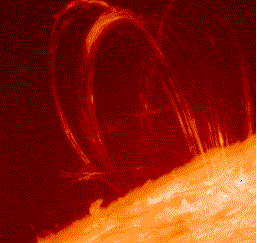
..::SUN::..

| SUN -- Attributes | ||
| Radius: 695,508 km | ||
| Surface temperature: 5,778 K |
||
| Mass: 1.989 × 10^30 kg | ||
| Escape velocity (from the surface): 617.7 km/s; 55 × Earth | ||
| Equatorial surface gravity: 274.0 m/s2; 27.94 g; 27,542.29 cgs; 28 × Earth | ||
| ... | ||
| Tone: 126.22 Hz = B (a1 = 449.9 Hz / 440 Hz + 38.1 cent) | ||
| Tempo: 118.3 bpm | ||
| Color: yellow-green | ||
| Chakra: Manipura - Solar Plexus (Hara) | ||
| Effect: advances the feeling of centering of the magic and of the transcendental | ||
| ... | ||
| The Sun is essentially a star that sits right in the center of our Solar System. 1.3 million Earths can fit inside the Sun. The Sun also makes up 99.86% of the mass of the Solar System. The Sun is one large majestic fire ball that is fundamental to life on Earth. All plants, trees and life would perish without it. | ||
|
...getting too close to the Sun can also get you burned.
|
||
..::MERCURY::..
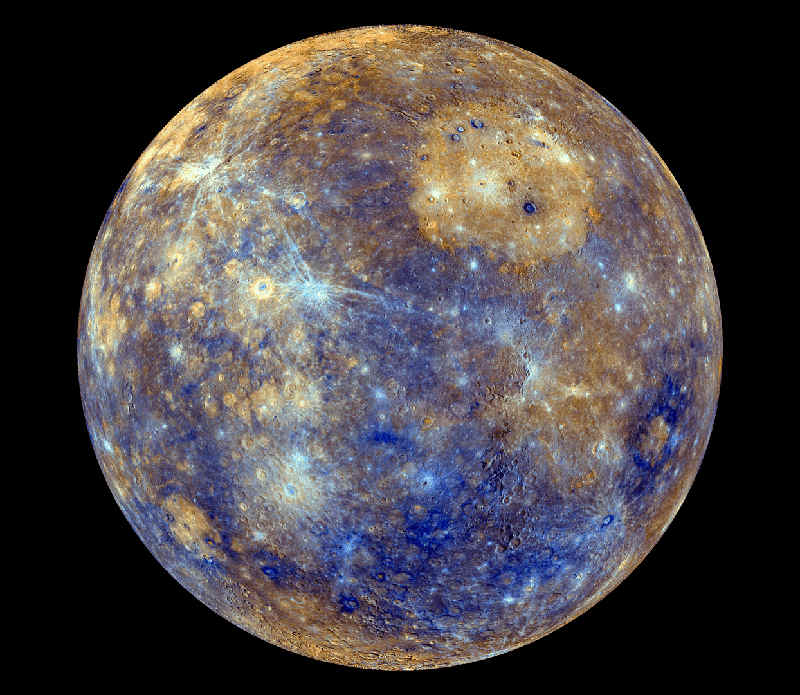
| MERCURY -- Attributes | ||
| Radius: 2,440 km | ||
| Surface area: 74.8 million km² |
||
| Mass: 3.285 × 10^23 kg (0.055 M⊕) | ||
| Distance from Sun: 57.91 million km | ||
| Orbital period: 88 days | ||
| ... | ||
| Tone: 141.27 Hz = C# (a1 = 448.5 Hz / 440 Hz + 33.2 cent) | ||
| Tempo: 66.2 / 132.4 bpm | ||
| Color: blue-green | ||
| Chakra: Vishudda - throat chakra | ||
| Effect: supports the speech center and the communicative-intellectual principle | ||
| ... | ||
|
Mercury is the first planet closest to the Sun. Lacking much of an atmsophere the planet exhibits extreme bipolar temperatures. Mercury's temperatures can go between -173 Celsius at night to 427 Celsius during the day. Mercury has no moons orbiting around it due to its very close proximity to the Sun. It is also worth noting that Venus, second planet from the Sun, also has no moons for the same reason. If either of these two planets were to have moons orbiting around it at too great of a distance they would most likely get pulled in by the Sun's magnetic field. If the moons were to orbit too closely to either of these planets they would most likely collide in tidal gravitational forces. Mercury only makes up 38% of Earth's diameter. Three Mercury planets side by side would be a bit wider than the Earth. Mercury is smaller than all the natural satellites of the Solar System - such as Ganymede and Titan. However, Mercury is far more dense than these satellites. |
||
|
|
||
|
The extreme cold and hot temperatures of Mercury would make for fatal living conditions... |
||
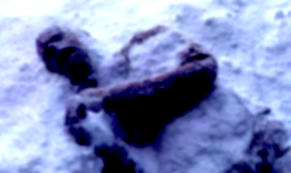  |
||
..::VENUS::..

| VENUS -- Attributes | ||
| Radius: 6,052 km | ||
| Surface area: 460.2 million km² |
||
| Mass: 4.867 × 10^24 kg (0.815 M⊕) | ||
| Distance from Sun: 108.2 million km | ||
| Orbital period: 225 days | ||
| ... | ||
| Tone: 221.23 Hz = A (a1 = 442.5 Hz / 440 Hz + 9.6 cent) | ||
| Tempo: 103.7 bpm | ||
| Color: yellow-orange | ||
| Chakra: Ajna - brow chakra, third eye | ||
| Effect: supports higher love energy and aspiration for harmony | ||
| ... | ||
|
Venus, having a similar composition and size compared to Earth, known as Earth's twin that orbits in the Sun's "habitable zone", is believed to have once been a habitable planet having warm shallow oceans that were suitable for sustaining life. But something tragic had happened and forever changed that world. Venus had lost its water due to the atmosphere clogging up with carbon dioxide and had incinerated itself due to runaway global warming. A scorching world of incinerated rocky landscapes, mountains and volcanoes are all that remains. Venus is a very corrosive planet that can be described as a planetary hell with its sulphuric acid clouds and extremely harsh environments. Its atmosphere has trace amounts of hydrogen fluoride, hydrogen chloride, hydrogen sulphide, and sulphuric acid. These chemicals have the ability to dissolve human flesh. The surface air is 97% carbon dioxide that is very compressed being 100 times thicker than Earth's atmosphere at a boiling 462 degrees Celsius. If one were to walk along the surface of Venus it would feel like walking through air that's as thick as a pool of water. It would feel like being 3,000 feet underwater due to the pressure. Venus is the second planet from the Sun. Just like Mercury, Venus has no moons orbiting around it due to its close proximity to the Sun. If Venus had moons orbiting at a far distance they would get pulled in by the Sun's magnetic field. If Venus had moons orbiting too closely to the planet they would collide in tidal gravitational forces. |
||
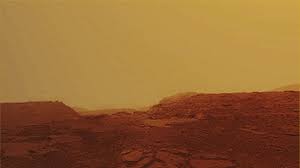  |
||
|
|
||
|
The extreme boiling hot temperatures on Venus makes for impossible living conditions... |
||
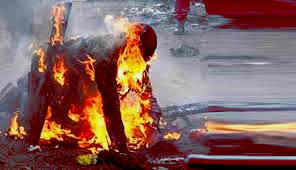 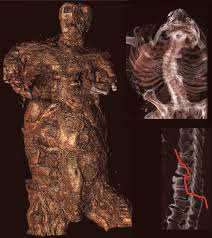 |
||
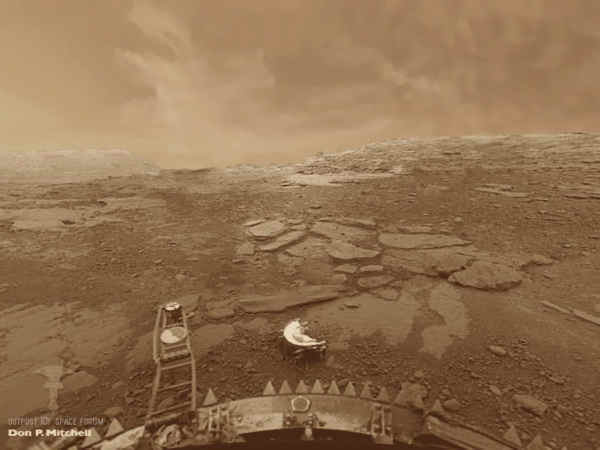 |
||
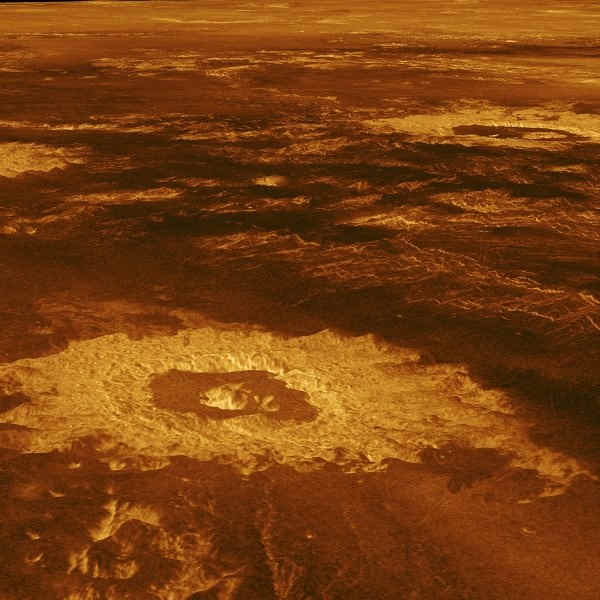 |
||
..::EARTH::..

| EARTH -- Attributes | ||
| Radius: 6,371 km | ||
| Surface area: 510.1 million km² |
||
| Mass: 5.972 × 10^24 kg | ||
| Distance from Sun: 149.6 million km | ||
| Orbital period: 365 days | ||
| ... | ||
| Earth is the 3rd planet from the Sun having only one natural orbiting satellite - the Moon. Earth, full of life and wonder. Our home, our dreams and sometimes our worst nightmare. | ||
  |
||
  |
||
  |
||
  |
||
..::MOON::..
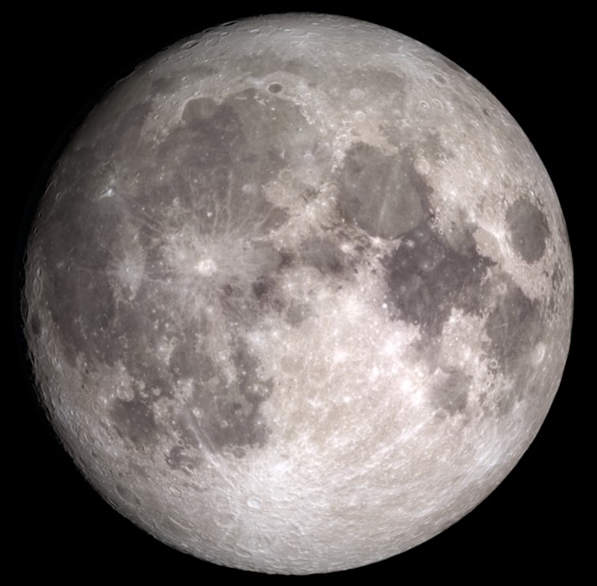
| MOON -- Attributes | ||
| Radius: 1,737 km | ||
| Surface area: 37.9 million square kilometers |
||
| Mass: 7.34767309 × 1022 kilograms | ||
| Distance to Earth: 384,400 km | ||
| Orbital period: 27 days | ||
| ... | ||
| Tone: 210.42 Hz = G# (a1 = 445.9 Hz / 440 Hz + 22.9 cent) | ||
| Tempo: 98.6 bpm | ||
| Color: orange | ||
| Chakra: Svadisthana - navel chakra | ||
| Effect: stimulates sexual energy, supports erotic communication, (medicinal: for woman it is good for regulation of menstration, in general disturbances of gland and lymph system) | ||
| ... | ||
| The Moon is the Earth's natural orbiting satellite. | ||
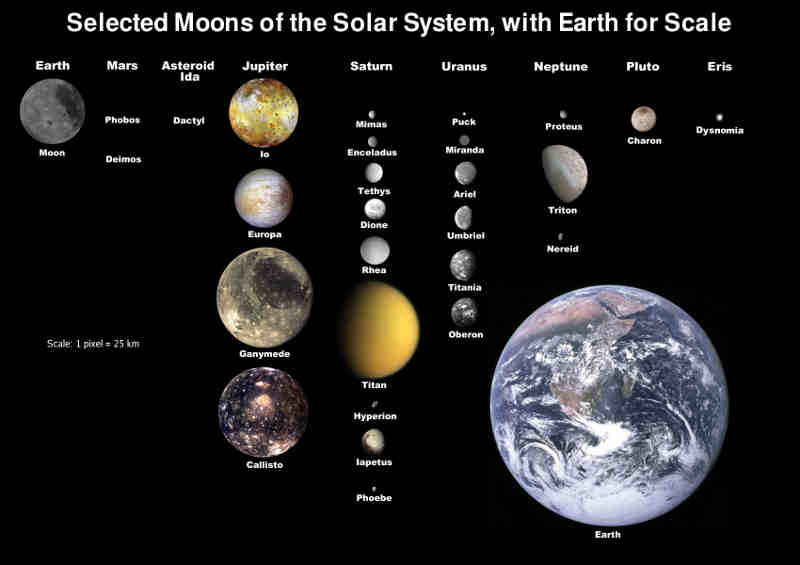
..::MARS::..
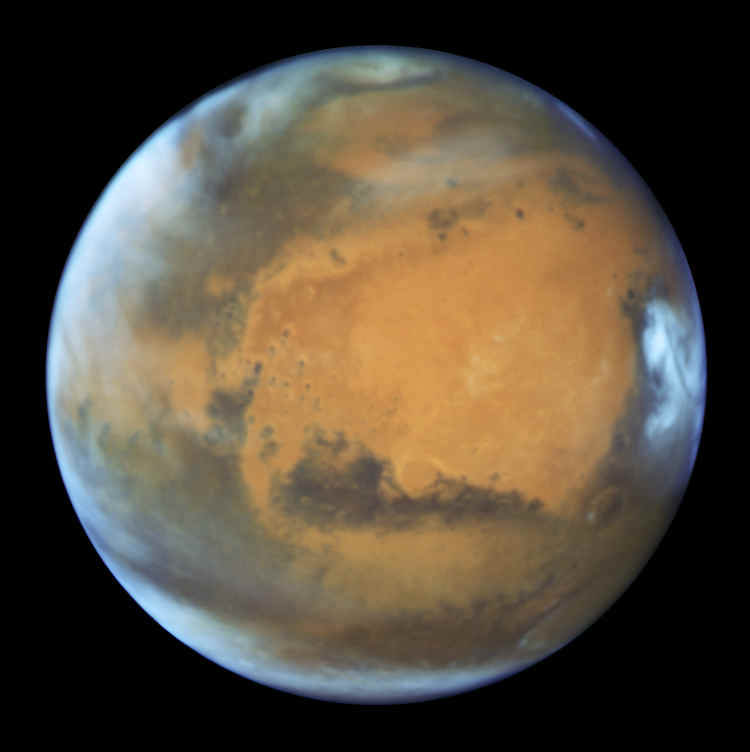
| MARS -- Attributes | ||
| Radius: 3,390 km | ||
| Surface area: 144.8 million km² |
||
| Mass: 6.39 × 10^23 kg (0.107 M⊕) | ||
| Distance from Sun: 227.9 million km | ||
| Orbital period: 687 days | ||
| ... | ||
| Tone: 144.72 Hz = D (a1 = 433.7 Hz / 440 Hz - 25.1 cent) | ||
| Tempo: 67.8 / 135.6 bpm | ||
| Color: blue | ||
| Effect: supports strenght of will and focused energy | ||
| ... | ||
| The 4th planet from the Sun. Mars is the most studied planet in the Solar System other than Earth. Scientists claim that Mars is a world full of potential. | ||
..::PHOBOS::..
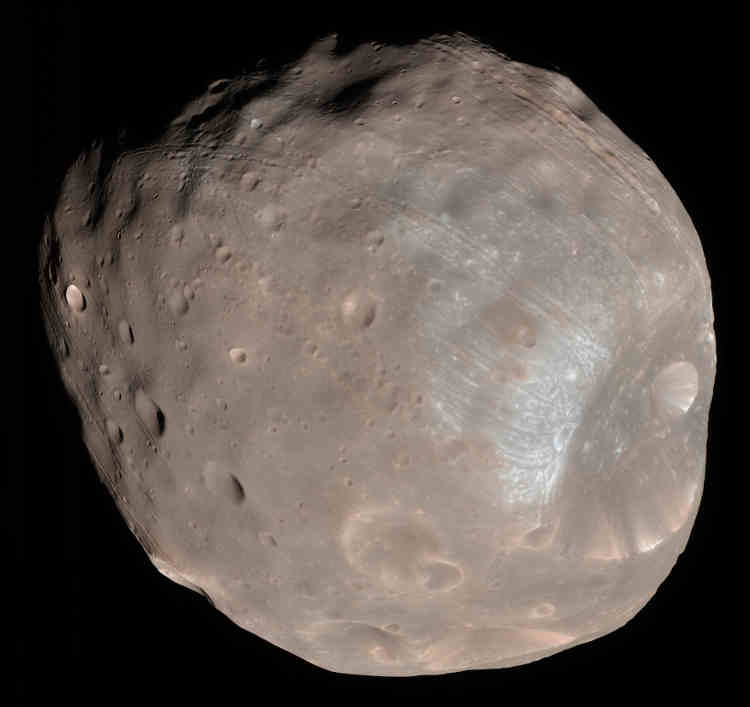
..::DEIMOS::..

..::JUPITER::..
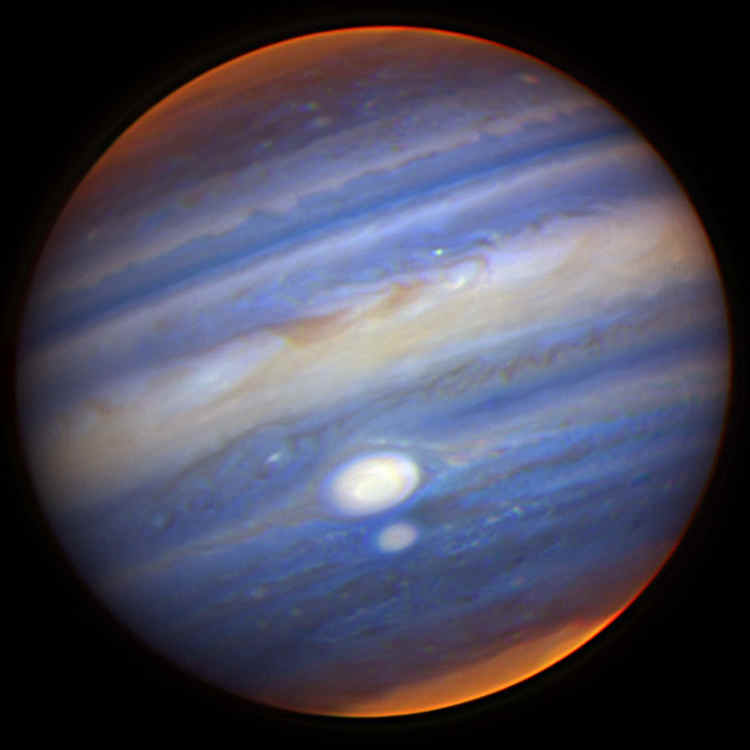
| JUPITER -- Attributes | ||
| Radius: 69,911 km | ||
| Surface area: 61.42 billion km² | ||
| Mass: 1.898 × 10^27 kg (317.8 M⊕) | ||
| Distance from Sun: 778.5 million km | ||
| Orbital period: 12 years | ||
| ... | ||
| Tone: 183.58 Hz = F# (a1 = 436.6 Hz / 440 Hz - 13.3 cent) | ||
| Tempo: 86.05 / 172.1 bpm | ||
| Color: red | ||
| Effect: supports creative power and continous construction | ||
| ... | ||
|
Approximately 1321 Earths can fit inside Jupiter with 3 being able to fit inside the Great Red Spot. The planet is almost 10 times smaller than the Sun. Jupiter is the largest planet in the solar system. Being 5th from the Sun. Jupiter has more mass than all other planets in our solar system combined. It is believed that Jupiter has 69 moons, four of which are the largest, called the Galilean moons. The four Galilean moons are called Io, Europa, Ganymede and Callisto. Life here on Earth would not be possible if it weren't for Jupiter's immensely powerful magnetosphere which acts as a solar vacuum pulling asteroids, comets, meteors and other astro debris into itself, thus completely redirecting any impending danger from encroaching the Earth. |
||
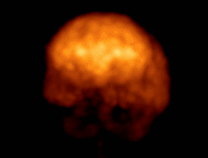
| THE FOUR GALILEAN MOONS OF JUPITER |
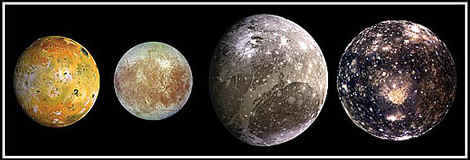
..::IO::..
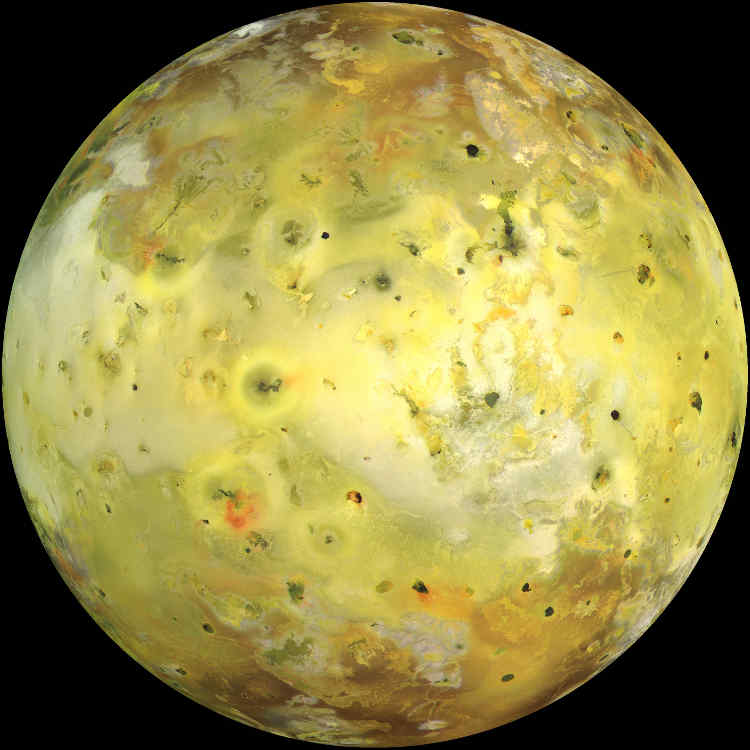
..::EUROPA::..
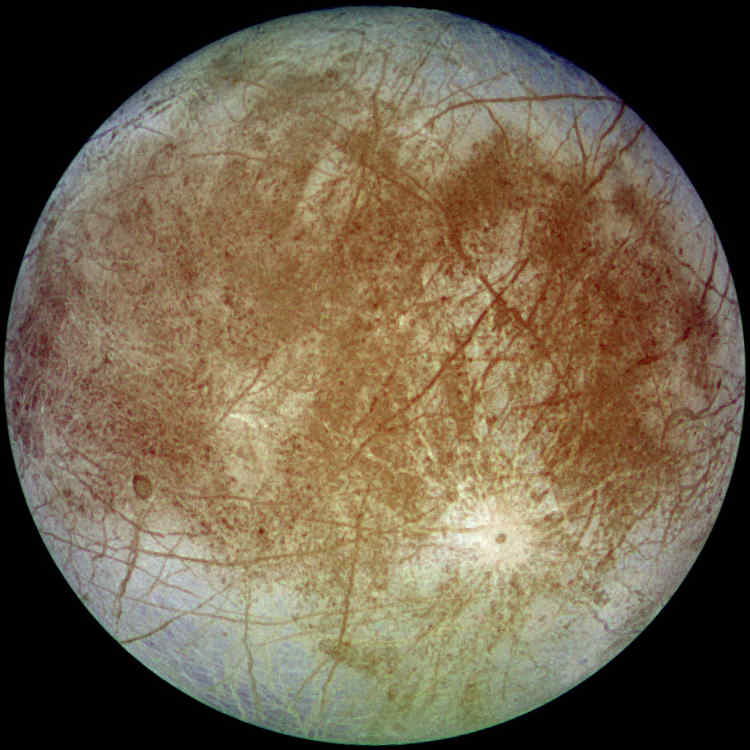
..::GANYMEDE::..
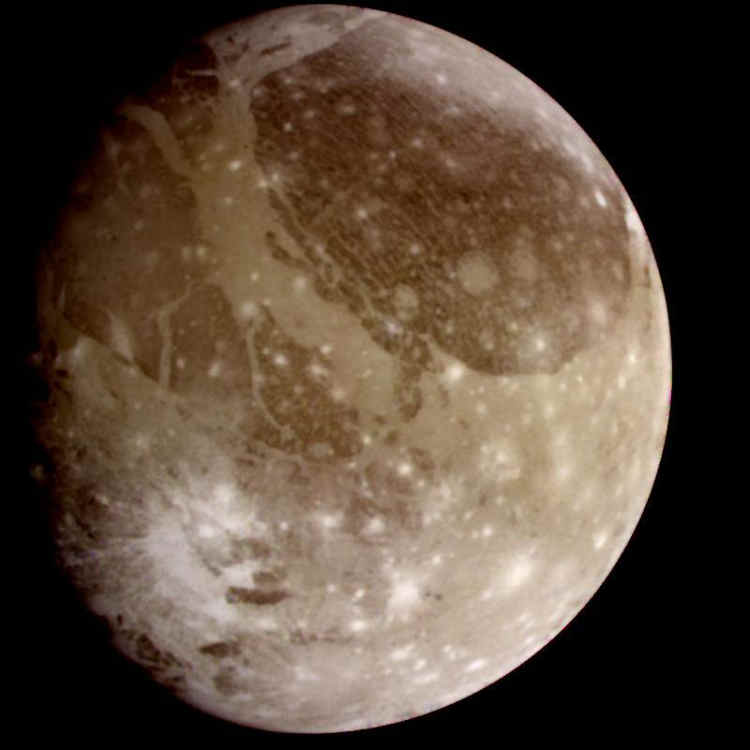
..::CALLISTO::..
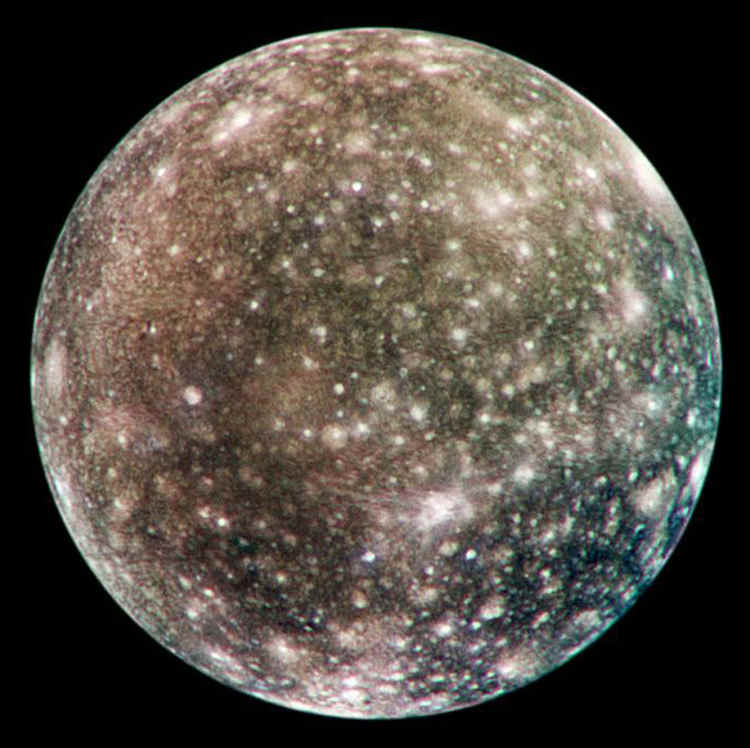

..::SATURN::..
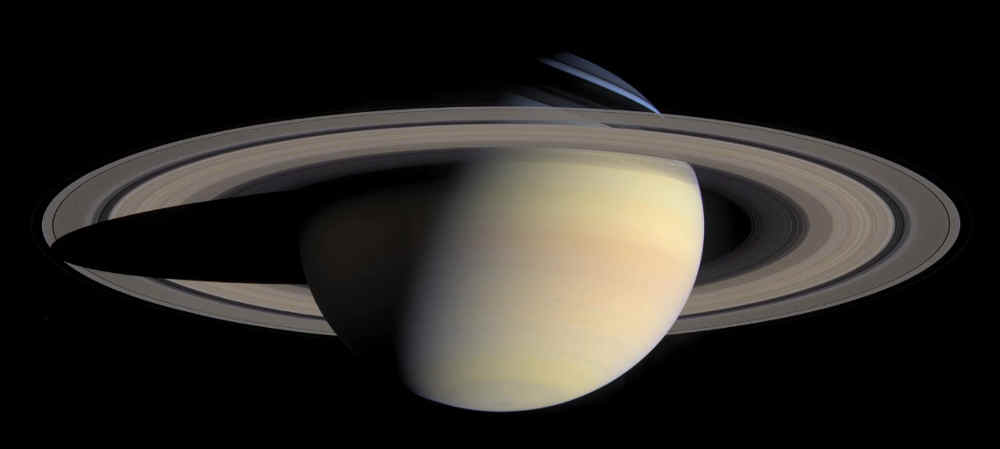
| SATURN -- Attributes | ||
| Radius: 58,232 km | ||
| Surface area: 42.7 billion km² |
||
| Mass: 5.683 × 10^26 kg (95.16 M⊕) | ||
| Distance from Sun: 1.433 billion km | ||
| Orbital period: 29 years | ||
| ... | ||
| Tone: 147.85 Hz = D (a1 = 443.0 Hz / 440 Hz + 11.9 cent) | ||
| Tempo: 69.3 / 138.6 bpm | ||
| Color: blue | ||
| Effect: enhances concentration and the process of becoming conscious, is considered to be a cosmic controller | ||
| ... | ||
| Being the 6th planet from the Sun. Saturn is a gas giant with an impressive ring system. It is the only planet in the Solar System that is less dense than water. 764 Earths could fit inside Saturn (if it was hollow) because it possesses about 764 times the volume of Earth. Saturn also has at least 150 moons and moonlets in total. Only about 53 moons have been given official names. Most of Saturn's moons are small and icy bodies that are a part of its ring system. |
||
..::URANUS::..

| URANUS -- Attributes | ||
| Radius: 25,362 km | ||
| Surface area: 8.083 billion km² |
||
| Mass: 8.681 × 10^25 kg (14.54 M⊕) | ||
| Distance from Sun: 2.871 billion km | ||
| Orbital period: 84 years | ||
| ... | ||
| Tone: 207.36 Hz = G# (a1 = 439.4 Hz / 440 Hz - 2.5 cent) | ||
| Tempo: 97.2 bpm | ||
| Color: orange | ||
| Effect: supports the power of surprise and renewal, has primeval and erotic power. | ||
| ... | ||
| Uranus is the 7th planet from the Sun. 63 Earths can fit inside of Uranus. | ||
..::NEPTUNE::..
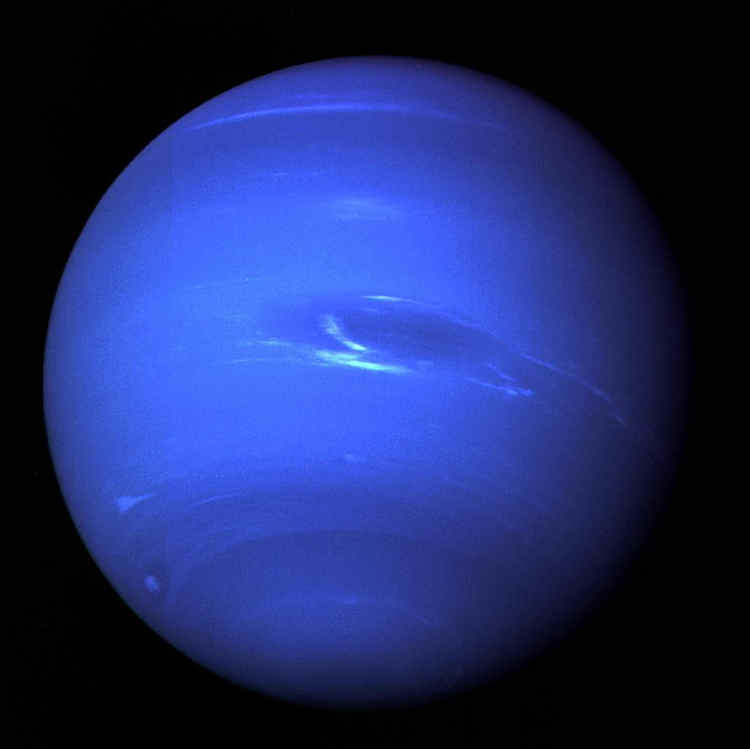
| NEPTUNE -- Attributes | ||
| Radius: 24,622 km | ||
| Surface area: 7.618 billion km² |
||
| Mass: 1.024 × 10^26 kg (17.15 M⊕) | ||
| Distance from Sun: 4.495 billion km | ||
| Orbital period: 165 years | ||
| ... | ||
| Tone: 211.44 Hz = G# (a1 = 448.0 Hz / 440 Hz + 31.3 cent) | ||
| Tempo: 99.1 bpm | ||
| Color: orange | ||
| Effect: supports intuition, the unconsciousness and enhances the dream experience. It is related to the antique God of the Sea. | ||
| ... | ||
| Neptune is the 8th planet from the Sun. 58 Earths can fit inside of Neptune. | ||
..::PLUTO::..
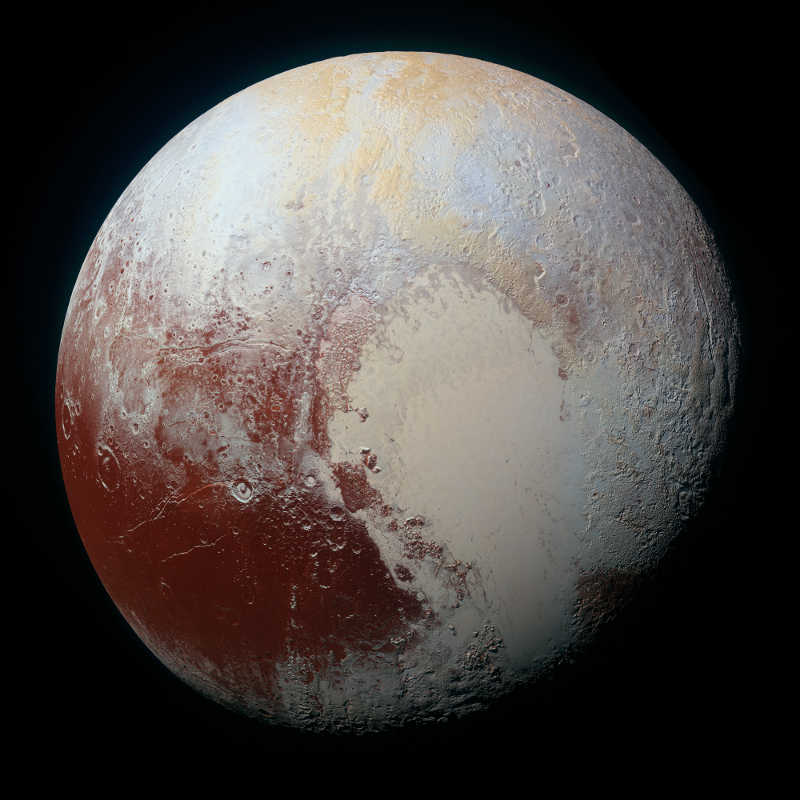
| PLUTO -- Attributes | ||
| Radius: 1,188 km | ||
| Surface area: 1.67 x 107 km² |
||
| Mass: 1.30900 × 1022 kilograms | ||
| Distance from Sun: 3.67 billion miles | ||
| Orbital period: 248 years | ||
| ... | ||
| Tone: 140.64 Hz = C# (a1 = 446.5 Hz / 440 Hz + 25.4 cent) | ||
| Tempo: 65.9 bpm | ||
| Color: blue-green | ||
| Effect: support the magic group dynamic principleand is said to be responsible for integration into certain structures of society | ||
| ... | ||
|
Pluto is the 9th planet from the Sun. Although Pluto was reclassified to "Dwarf planet" by the International Astronomical Union (IAU) in 2006. It is half as wide as the United Sates. Pluto is smaller than the Earth's moon and one day on Pluto is approximately equivalent to 6 1/2 Earth days. Pluto possesses 5 moons with the largest moon named as Charon (KAIR-ən). The names of Pluto's four other moons are Kerberos, Styx, Nix and Hydra. Pluto is much colder than Antarctica. It is extremely cold that Earth's air would be frozen solid. |
||

![]()
![]()
![]()
![]()
![]()
![]()
![]()
![]()
This web page was created by J.M. 2018 - 2019. About.